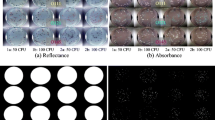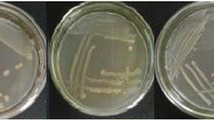Abstract
The most widely used method of identification of microbial morphology and structure is microscopy, but it can be difficult to distinguish between pathogens with a similar appearance. Existing fluorescent staining methods require a combination of a variety of fluorescent materials to meet this demand. In this study, unique concentration-dependent fluorescent carbon dots (CDs) were synthesized for the identification and quantification of pathogens. The emission wavelength of the CDs could be tuned spanning the full visible region by virtue of aggregation-induced narrowing of bandgaps. This tunable emission wavelength of the specific concentration response to diverse microbes can be used to distinguish microorganisms with a similar appearance, even in a same genus. A hyperspectral microscopy system was demonstrated to distinguish Aspergillus flavus and A. fumigatus based on the results above. The identification accuracy of the two similar-looking pathogens can be close to 100%, and the relative proportions and spatial distributions can also be profiled from the mixture of the pathogens. This technique can provide a solution to the fast detection of microorganisms and is potentially applicable to a wide range of problems in areas such as healthcare, food preparation, biotechnology, and health emergency.

Similar content being viewed by others
References
Mannoor, M. S.; Zhang, S. Y.; Link, A. J.; McAlpine, M. C. Electrical detection of pathogenic bacteria via immobilized antimicrobial peptides. Proc. Natl. Acad. Sci. USA 2010, 107, 19207–19212.
Infoplease Staff. Common infectious diseases worldwide[Online]. 2017. https://www.infoplease.com/math-science/health/diseases/common-infectious-diseases-worldwide (accessed Jun 5, 2021).
Lazcka, O.; Del Campo, F. J.; Munoz, F. X. Pathogen detection: A perspective of traditional methods and biosensors. Biosens. Bioelectron. 2007, 22, 1205–1217.
Borst, A.; Box, A. T. A.; Fluit, A. C. False-positive results and contamination in nucleic acid amplification assays: Suggestions for a prevent and destroy strategy. Eur. J. Clin. Microbiol. Infect. Dis. 2004, 23, 289–299.
Jyoti, A.; Ram, S.; Vajpayee, P.; Singh, G.; Dwivedi, P. D.; Jain, S. K.; Shanker, R. Contamination of surface and potable water in South Asia by Salmonellae: Culture-independent quantification with molecular beacon real-time PCR. Sci. Total Environ. 2010, 408, 1256–1263.
Li, M.; Gu, J. D. Advances in methods for detection of anaerobic ammonium oxidizing (anammox) bacteria. Appl. Microbiol. Biotechnol. 2011, 90, 1241–1252.
Brandily, M. L.; Monbet, V.; Bureau, B.; Boussard-Plédel, C.; Loréal, O.; Adam, J. L.; Sire, O. Identification of foodborne pathogens within food matrices by IR spectroscopy. Sens. Actuat. B: Chem. 2011, 160, 202–206.
Moreirinha, C.; Almeida, A.; Saraiva, J. A.; Delgadillo, I. High-pressure processing effects on foodborne bacteria by mid-infrared spectroscopy analysis. LWT 2016, 73, 212–218.
Bai, H. T.; Chen, H.; Hu, R.; Li, M.; Lv, F. T.; Liu, L. B.; Wang, S. Supramolecular conjugated polymer materials for in situ pathogen detection. ACS Appl. Mater. Interfaces 2016, 8, 31550–31557.
Doria, G.; Conde, J.; Veigas, B.; Giestas, L.; Almeida, C.; Assunção, M.; Rosa, J.; Baptista, P. V. Noble metal nanoparticles for biosensing applications. Sensors 2012, 12, 1657–1687.
Sastry, R. K.; Anshul, S.; Rao, N. H. Nanotechnology in food processing sector-an assessment of emerging trends. J. Food Sci. Technol. 2013, 50, 831–841.
Aurich, K.; Wesche, J.; Palankar, R.; Schlüter, R.; Bakchoul, T.; Greinacher, A. Magnetic nanoparticle labeling of human platelets from platelet concentrates for recovery and survival studies. ACS Appl. Mater. Interfaces 2017, 9, 34666–34673.
Zhou, Q.; Liu, X. X.; Tian, Y.; Wu, M.; Niu, Z. W. Mussel-inspired polydopamine coating on tobacco mosaic virus: One-dimensional hybrid nanofibers for gold nanoparticle growth. Langmuir 2017, 33, 9866–9872.
Li, S. Y.; Wang, F.; Li, X. Q.; Chen, J.; Zhang, X. H.; Wang, Y. C.; Liu, J. W. Dipole orientation matters: Longer-circulating choline phosphate than phosphocholine liposomes for enhanced tumor targeting. ACS Appl. Mater. Interfaces 2017, 9, 17736–17744.
Zhou, C. C.; Xu, W. H.; Zhang, P. B.; Jiang, M. J.; Chen, Y. C.; Kwok, R. T. K.; Lee, M. M. S.; Shan, G. G.; Qi, R. L.; Zhou, X. et al. Engineering sensor arrays using aggregation-induced emission luminogens for pathogen identification. Adv. Funct. Mater. 2019, 29, 1805986.
Zhang, Y. Q.; Li, C. F.; Fan, Y.; Wang, C. B.; Yang, R. F.; Liu, X. Y.; Zhou, L. A self-quenching-resistant carbon nanodot powder with multicolored solid-state fluorescence for ultra-fast staining of various representative bacterial species within one minute. Nanoscale 2016, 8, 19744–19753.
Zhang, Y. Q.; Liu, X. Y.; Fan, Y.; Guo, X. Y.; Zhou, L.; Lv, Y.; Lin, J. One-step microwave synthesis of N-doped hydroxyl-functionalized carbon dots with ultra-high fluorescence quantum yields. Nanoscale 2016, 8, 15281–15287.
Ru, Y.; Sui, L. Z.; Song, H. Q.; Liu, X. J.; Tang, Z. Y.; Zang, S. Q.; Yang, B.; Lu, S. Y. Rational design of multicolor-emitting chiral carbonized polymer dots for full-color and white circularly polarized luminescence. Angew. Chem., Int. Ed. 2021, 60, 14091–14099.
Lan, M. H.; Zhao, S. J.; Wu, S. L.; Wei, X. F.; Fu, Y. Z.; Wu, J. J.; Wang, P. F.; Zhang, W. J. Optically tunable fluorescent carbon nanoparticles and their application in fluorometric sensing of copper ions. Nano Res. 2019, 12, 2576–2583.
Wang, B. Y.; Yu, J. K.; Sui, L. Z.; Zhu, S. J.; Tang, Z. Y.; Yang, B.; Lu, S. Y. Rational design of multi-color-emissive carbon dots in a single reaction system by hydrothermal. Adv. Sci. 2021, 8, 2001453.
Li, W. D.; Zhao, Y. X.; Liu, Y.; Sun, M. Z.; Waterhouse, G. I. N.; Huang, B. L.; Zhang, K.; Zhang, T. R.; Lu, S. Y. Exploiting Ru-induced lattice strain in CoRu nanoalloys for robust bifunctional hydrogen production. Angew. Chem., Int. Ed. 2021, 60, 3290–3298.
Yang, S. H.; Sun, X. H.; Wang, Z. Y.; Wang, X. Y.; Guo, G. S.; Pu, Q. S. Anomalous enhancement of fluorescence of carbon dots through lanthanum doping and potential application in intracellular imaging of ferric ion. Nano Res. 2018, 11, 1369–1378.
Bao, X.; Yuan, Y.; Chen, J. Q.; Zhang, B. H.; Li, D.; Zhou, D.; Jing, P. T.; Xu, G. Y.; Wang, Y. L.; Holá, K. et al. In vivo theranostics with near-infrared-emitting carbon dots-highly efficient photothermal therapy based on passive targeting after intravenous administration. Light Sci. Appl. 2018, 7, 91.
Song, H. Q.; Wu, M.; Tang, Z. Y.; Tse, J. S.; Yang, B.; Lu, S. Y. Single atom Ruthenium-doped CoP/CDs nanosheets via splicing of carbon-dots for robust hydrogen production. Angew. Chem., Int. Ed. 2021, 60, 7234–7244.
Qu, S. N.; Liu, X. Y.; Guo, X. Y.; Chu, M. H.; Zhang, L.; Shen, D. Z. Amplified spontaneous green emission and lasing emission from carbon nanoparticles. Adv. Funct. Mater. 2014, 24, 2689–2695.
Qu, D.; Zheng, M.; Li, J.; Xie, Z. G.; Sun, Z. C. Tailoring color emissions from N-doped graphene quantum dots for bioimaging applications. Light Sci. Appl. 2015, 4, e364.
Song, H. Q.; Li, Y. H.; Shang, L.; Tang, Z. Y.; Zhang, T. R.; Lu, S. Y. Designed controllable nitrogen-doped carbon-dots-loaded MoP nanoparticles for boosting hydrogen evolution reaction in alkaline medium. Nano Energy 2020, 72, 104730.
Zhang, M. R.; Su, R. G.; Zhong, J.; Fei, L.; Cai, W.; Guan, Q. W.; Li, W. J.; Li, N.; Chen, Y. S.; Cai, L. L. et al. Red/orange dual-emissive carbon dots for pH sensing and cell imaging. Nano Res. 2019, 12, 815–821.
Liu, Y.; Li, X.; Zhang, Q. H.; Li, W. D.; Xie, Y.; Liu, H. Y.; Shang, L.; Liu, Z. Y.; Chen, Z. M.; Gu, L. et al. A general route to prepare low-ruthenium-content bimetallic electrocatalysts for pH-universal hydrogen evolution reaction by using carbon quantum dots. Angew. Chem., Int. Ed. 2020, 132, 1735–1743.
Wang, Z. G.; Fu, B. S.; Zou, S. W.; Duan, B.; Chang, C. Y.; Yang, B.; Zhou, X.; Zhang, L. Facile construction of carbon dots via acid catalytic hydrothermal method and their application for target imaging of cancer cells. Nano Res. 2016, 9, 214–223.
Yan, J. A., Xian, L. D.; Chou, M. Y. Structural and electronic properties of oxidized graphene. Phys. Rev. Lett. 2009, 103, 086802.
Zhang, Y. Q.; Hu, Y. S.; Lin, J.; Fan, Y.; Li, Y. T.; Lv, Y.; Liu, X. Y. Excitation wavelength independence: Toward low-threshold amplified spontaneous emission from carbon nanodots. ACS Appl. Mater. Interfaces 2016, 8, 25454–25460.
Zhang, Y. Q.; Zhuo, P.; Yin, H.; Fan, Y.; Zhang, J. H.; Liu, X. Y.; Chen, Z. Q. Solid-state fluorescent carbon dots with aggregation-induced yellow emission for white light-emitting diodes with high luminous efficiencies. ACS Appl. Mater. Interfaces 2019, 11, 24395–24403.
Ritter, K. A.; Lyding, J. W. The influence of edge structure on the electronic properties of graphene quantum dots and nanoribbons. Nat. Mater. 2009, 8, 235–242.
Zhu, S. J.; Song, Y. B.; Wang, J.; Wan, H.; Zhang, Y.; Ning, Y.; Yang, B. Photoluminescence mechanism in graphene quantum dots: Quantum confinement effect and surface/edge state. Nano Today 2017, 13, 10–14.
Kasprzyk, W.; Bednarz, S.; Żmudzki, P.; Galica, M.; Bogdał, D. Novel efficient fluorophores synthesized from citric acid. RSC Adv. 2015, 5, 34795–34799.
Song, Y. B.; Zhu, S. J.; Zhang, S. T.; Fu, Y.; Wang, L.; Zhao, X. H.; Yang, B. Investigation from chemical structure to photoluminescent mechanism: A type of carbon dots from the pyrolysis of citric acid and an amine. J. Mater. Chem. C 2015, 3, 5976–5984.
Shi, L.; Yang, J. H.; Zeng, H. B.; Chen, Y. M.; Yang, S. C.; Wu, C.; Zeng, H.; Yoshihito, O.; Zhang, Q. Q. Carbon dots with high fluorescence quantum yield: The fluorescence originates from organic fluorophores. Nanoscale 2016, 8, 14374–14378.
Zhang, J.; Yang, L.; Yuan, Y.; Jiang, J.; Yu, S. H. One-pot gram-scale synthesis of nitrogen and sulfur embedded organic dots with distinctive fluorescence behaviors in free and aggregated states. Chem. Mater. 2016, 28, 4367–4374.
Lv, P. Y.; Sun, S. L.; Lin, C. Q.; Liu, G. R. Space moving target detection and tracking method in complex background. Infrared Phys. Technol. 2018, 91, 107–118.
Zhang, X. M.; Gong, W. Y.; Xu, X. B. Magnetic ring multi-defect stereo detection system based on multi-camera vision technology. Sensors 2020, 20, 392.
Loong, T. W. Understanding sensitivity and specificity with the right side of the brain. BMJ 2003, 327, 716–719.
Suk, H. I.; Wee, C. Y.; Lee, S. W. Shen, D. G. Supervised discriminative group sparse representation for mild cognitive impairment diagnosis. Neuroinformatics 2015, 13, 277–295.
Akram, M. U.; Khalid, S.; Khan, S. A. Identification and classification of microaneurysms for early detection of diabetic retinopathy. Pattern Recognit. 2013, 46, 107–116.
Kim, J.; Lee, B. Identification of Alzheimer’s disease and mild cognitive impairment using multimodal sparse hierarchical extreme learning machine. Hum. Brain Mapp. 2018, 39, 3728–3741.
Ding, H. Z.; Xu, J. H.; Jiang, L.; Dong, C.; Meng, Q.; Rehman, S. U.; Wang, J. F.; Ge, Z. S.; Osipov, V. Y.; Bi, H. Fluorine-defects induced solid-state red emission of carbon dots with an excellent thermosensitivity. Chin. Chem. Lett., in press, https://doi.org/10.1016/j.cclet.2021.04.033.
Acknowledgments
This work was supported by the National Natural Science Foundation of China (NSFC) (Nos. 61935010, 61975069, 21905253, and 51973200), the China Postdoctoral Science Foundation (Nos. 2018M640681 and 2019T120632), the Natural Science Foundation of Henan (No. 202300410372), Key-Area Research and Development Program of Guangdong Province (No. 2020B090922006), Guangdong Project of Science and Technology Grants (No. 2018B030323017), Guangzhou science and technology project (Nos. 201903010042 and 201904010294), Youth project of science and technology research program of Chongqing Education Commission of China (No. KJQN202001322), and the Science and Technology Development Fund from Macau SAR (File Nos. 0125/2018/A3 and 0071/2019/AMJ).
Author information
Authors and Affiliations
Corresponding authors
Electronic Supplementary Material
Rights and permissions
About this article
Cite this article
Zhang, Y., Liu, K., Yu, J. et al. Single stain hyperspectral imaging for accurate fungal pathogens identification and quantification. Nano Res. 15, 6399–6406 (2022). https://doi.org/10.1007/s12274-021-3776-2
Received:
Revised:
Accepted:
Published:
Issue Date:
DOI: https://doi.org/10.1007/s12274-021-3776-2




